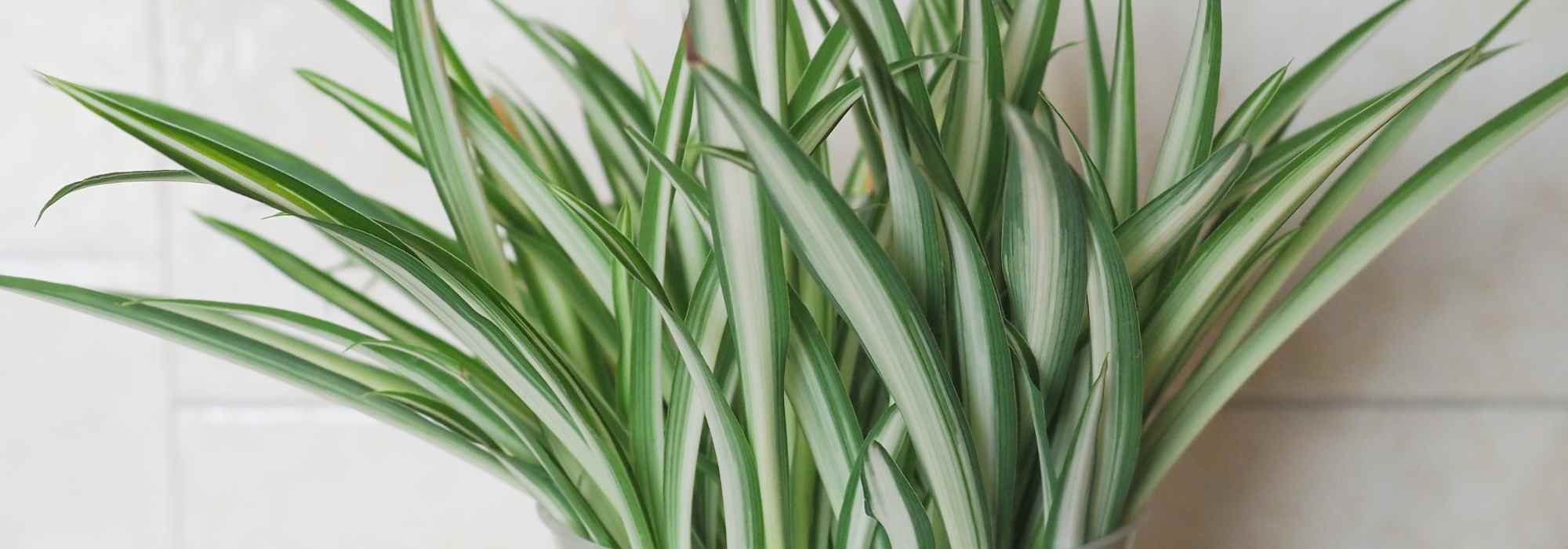
Chlorophytum - Spider plant: planting and growing
Contents
The spider plant in a nutshell
- The Chlorophytum is a robust and decorative indoor plant, ideal for beginners.
- Its ribbon-like foliage and graceful stolons bring lightness and movement to any space.
- Easy to care for, it prefers indirect light and moderate watering.
- It propagates easily by layering on compost or in water.
- In addition to being aesthetically pleasing, it naturally purifies the surrounding air.
The word from our expert
The Chlorophytum, also known as spider plant or ribbon plant, is an essential houseplant thanks to its natural beauty and ease of care. Native to the tropical undergrowth of southern Africa, this perennial plant charms with its ribbon-like, flexible foliage, often variegated with white or cream depending on the variety. Its trailing habit and graceful stolons add lightness and movement to any interior, whether modern, bohemian, or vintage.
Its hardiness makes the Chlorophytum an ideal choice for both novice gardeners and enthusiasts. Undemanding, it adapts to various light conditions, though it prefers bright, indirect light. Its fleshy root system allows it to tolerate occasional missed waterings, while its air-purifying properties improve indoor air quality. The Chlorophytum is also very easy to propagate thanks to its stolons, which produce small seedlings ready to root.
In terms of care, this plant requires moderate watering, a light and well-draining substrate, and repotting every two years to support its rapid growth. Regular feeding with green plant fertiliser in spring and summer encourages dense foliage and stolon production. Relatively resistant to diseases, it can still be prone to mealybugs or spider mites in overly dry air, but these issues are easily resolved with appropriate care.
Decorative and versatile, the Chlorophytum fits perfectly in macramé hanging pots, terracotta planters, or natural fibre baskets, showcasing its trailing foliage. A true ally for indoor well-being, it combines elegance and simplicity, while adding a touch of fresh greenery to every space. Adopting a Chlorophytum means inviting nature into your home with style and ease.
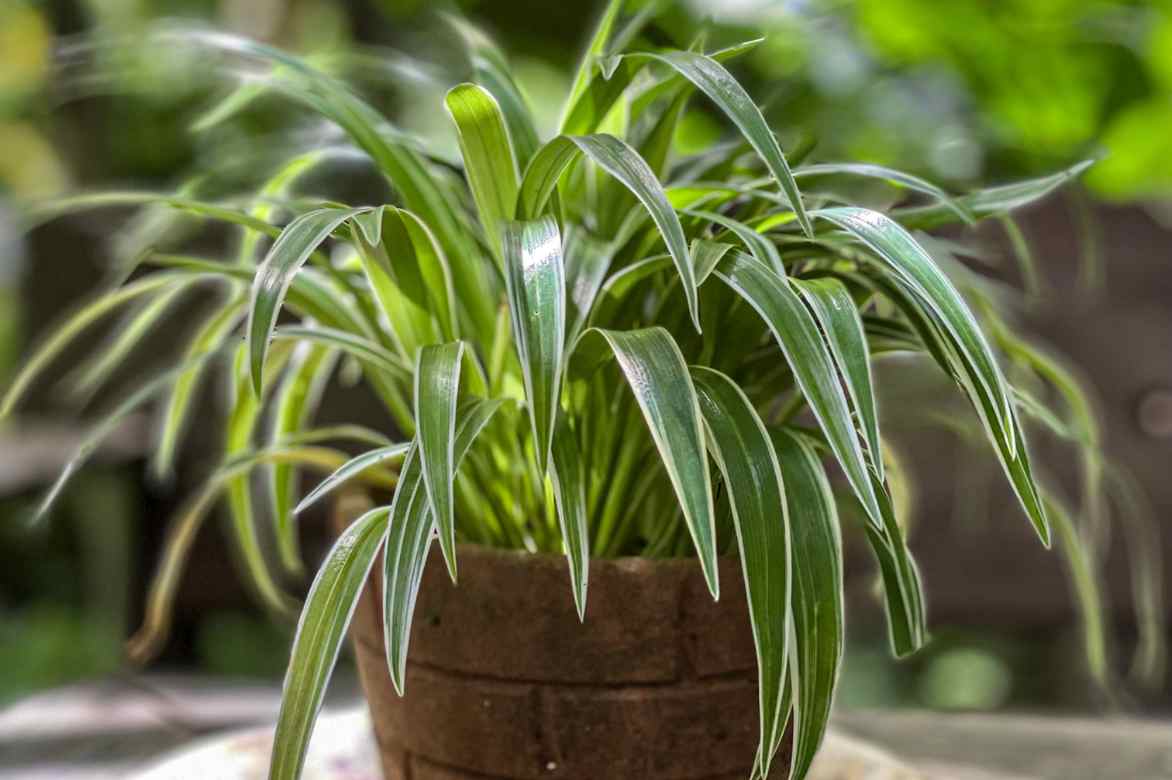
Chlorophytum comosum
Botany and description
Botanical data
- Latin name Chlorophytum comosum
- Family Asparagaceae
- Common name Spider plant, ribbon plant
- Flowering June-July
- Height 50 cm
- Exposure bright light without direct sunlight
- Soil type houseplant compost
- Hardiness 5°C
The Chlorophytum, commonly known as the spider plant, belongs to the botanical family Asparagaceae. The genus name, Chlorophytum, comes from the Greek “chloros”, meaning pale green, and “phyton”, meaning plant, a direct reference to the soft hue of its foliage. In French, this plant is known by several evocative names such as spider plant, ribbon plant, chlorophyton, or even hen-and-chickens, and even “plante vaudoise” in Switzerland. All these names reflect the graceful form of its long ribbon-like leaves and its stolons, which resemble spider legs.
In its natural habitat, Chlorophytum thrives in the tropical and subtropical undergrowth of southern Africa. There, it grows sheltered from direct light, in humid and shaded areas where it benefits from rich, well-drained soil. It is precisely this adaptability that explains its immense popularity as a houseplant. Resilient and undemanding, Chlorophytum tolerates missed waterings, variations in light, and even dry air, making it an ideal choice for beginners. Its decorative foliage and air-purifying abilities only enhance its success in homes and offices.
Among the most common species and cultivars of Chlorophytum, the Chlorophytum comosum remains the undisputed star of interiors. Its popularity stems from its ease of care and graceful foliage, which instantly adds a touch of greenery. This species comes in several cultivars, each offering varied leaf shades and forms to suit all styles.
The most widespread is the Chlorophytum comosum ‘Variegatum’, with its long green leaves edged in creamy white, bringing brightness and lightness to spaces. Equally popular, the ‘Vittatum’ stands out with its green leaves marked by a central white stripe, creating a lovely contrast. More original, the ‘Bonnie’ charms with its shorter, undulate leaves, forming compact rosettes with a dynamic and modern style. The ‘Ocean’ cultivar offers a more subdued version with its thick green leaves edged in white, while the ‘Irish’ distinguishes itself with its entirely green, denser, and deeper foliage. The latter is perfect for those who prefer a more natural and intense greenery effect, without the variegation of other varieties.
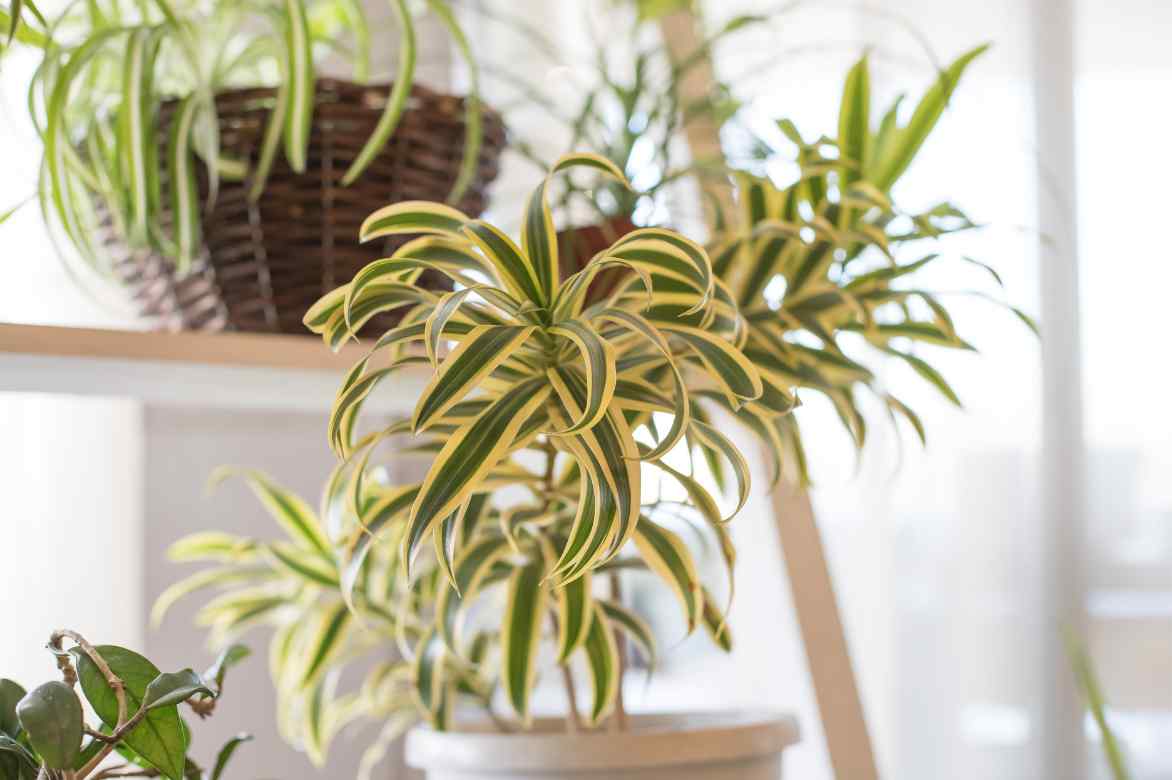
Chlorophytum comosum ‘Variegatum’
The Chlorophytum has a soft and elegant habit, forming a dense rosette of long, arching leaves that gracefully trail around the base. This airy silhouette gives the plant a light and fluid appearance, perfect for hanging or placing on a high piece of furniture to allow its trailing leaves to cascade freely.
Its root system is particularly interesting: it consists of thick, fleshy roots, sometimes tuberous, which serve as reserves of water and nutrients. This natural adaptation allows it to better withstand periods of drought or missed waterings. This robust underground network also contributes to the plant’s overall vigour.
The Chlorophytum is also distinguished by its stolons, long, slender stems that extend from the base of the plant. These stolons bear miniature rosettes of leaves at their tips, resembling the mother plant. When in contact with soil or a humid medium, these young shoots quickly develop roots, allowing the Chlorophytum to self-layer naturally and multiply without human intervention. This vegetative mode of reproduction explains its ability to colonise its environment easily.
The foliage of the Chlorophytum is another of its major assets. Its leaves are long, ribbon-like, and flexible, measuring up to 45 cm depending on the variety. Depending on the cultivar, they can be uniformly green or variegated with white or cream, with subtle patterns ranging from coloured edges to a lighter central stripe. This graphic and trailing foliage adds a lot of lightness to the overall plant.
Its flowering, though discreet, adds an extra touch of charm. The Chlorophytum produces small, star-shaped white flowers that bloom along its stolons. These delicate flowers are often followed by the appearance of young plantlets.
In some cultures, giving a Chlorophytum is seen as a symbol of prosperity and abundance, as its stolons producing plantlets evoke continuous growth and renewal. It is not uncommon for this plant to be passed down through generations, with each cutting becoming a little green heirloom in families. Moreover, some people affectionately nickname this plant “mother hen”, due to its stolons dangling like little chicks clinging to their mother.
Did you know? In the 1980s, NASA conducted research on plants capable of purifying the air in space stations, and Chlorophytum proved particularly effective at absorbing common pollutants such as formaldehyde, carbon monoxide, and benzene. This ability earned it a prominent place in many interiors, not only for its beauty but also for its role in improving air quality.
Cultivation and Care of the Spider Plant
Growing a Chlorophytum is child’s play, which explains why this plant is so popular among beginners and gardening enthusiasts alike. To ensure it thrives, a few essential elements need to be considered.
Light
Chlorophytum loves bright, indirect light. A spot near an east or west-facing window is ideal. It also tolerates partial shade, but its variegated leaves will be more vibrant with sufficient light. Direct sunlight, especially in the afternoon, may scorch its leaves.
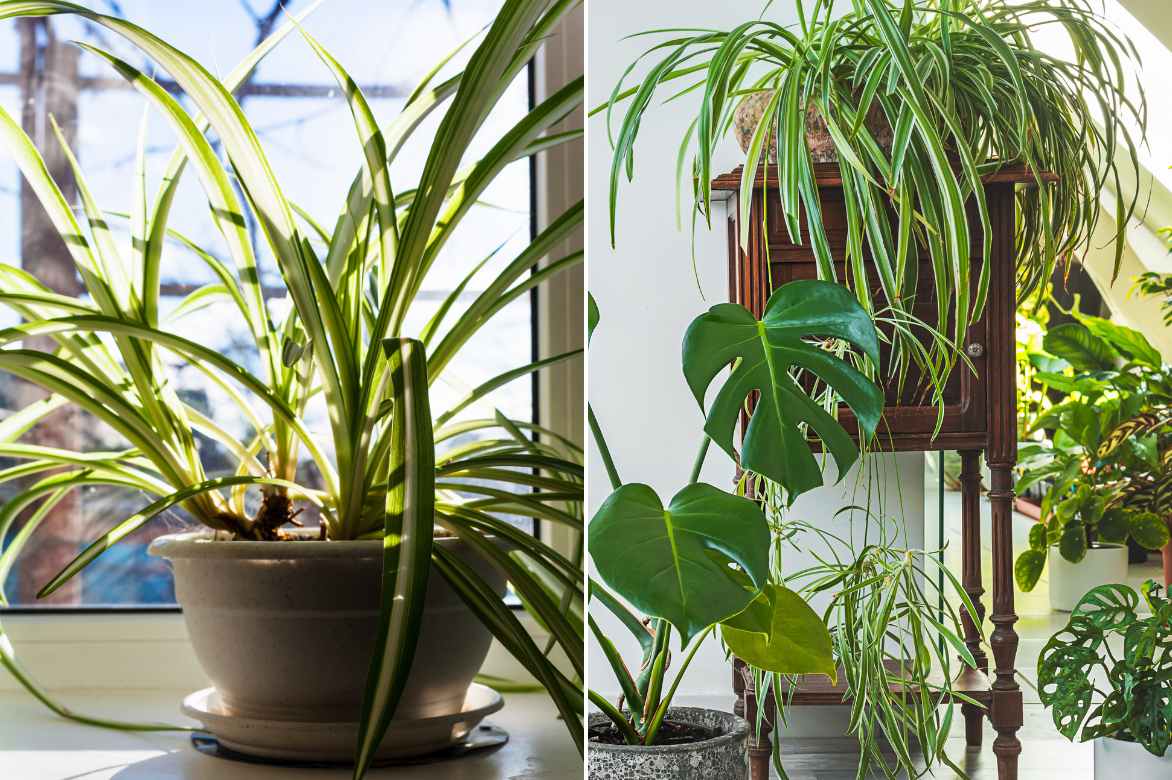
A bright spot suits it well
Type of pot
A terracotta or plastic pot with drainage holes is perfect. Since Chlorophytum has a vigorous and fleshy root system, it appreciates pots that are slightly snug. This encourages the production of stolons and young shoots.
Type of substrate
It prefers a light and well-draining substrate. A mix of houseplant compost with a bit of sand or perlite is ideal to avoid water retention. A compact compost could lead to root rot.
Repotting
Chlorophytum grows quickly, so it’s advisable to repot it every 1 to 2 years, preferably in spring. Once the roots start to overflow from the pot or growth slows down, it’s a sign that it needs more space.
Watering
The spider plant enjoys regular but moderate watering. Allow the top few centimetres of the substrate to dry out between waterings. In summer, this might mean watering once a week, while in winter, watering every two to three weeks is sufficient. Be careful not to let water stagnate in the saucer, as its fleshy roots are sensitive to excess moisture.
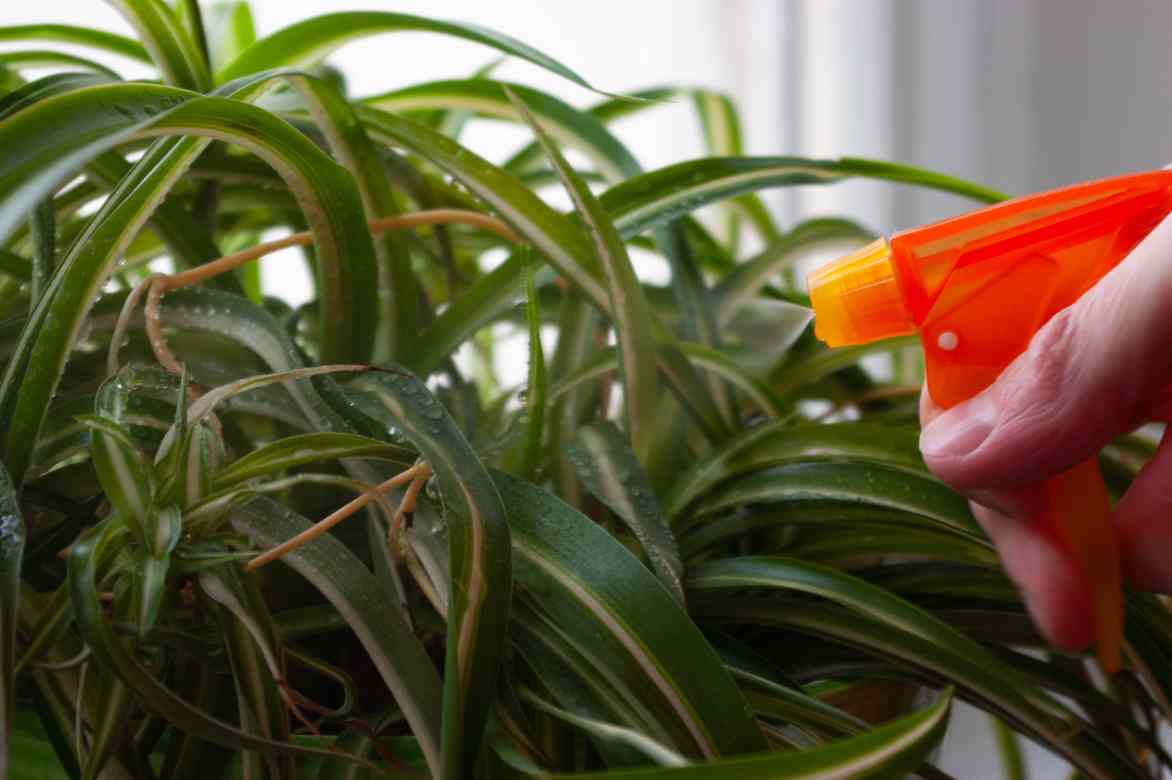
Fertilisation
A liquid fertiliser for houseplants, rich in nitrogen (N) to promote leaf growth, is ideal. An application every 2 to 3 weeks is more than enough. In winter, when the plant enters dormancy, it’s best to suspend fertiliser applications.
Pruning
Pruning isn’t essential, but you can trim damaged or yellowing leaves to keep the plant looking attractive. You can also prune the stolons if you want to limit their spread or take cuttings.
Diseases and parasitic pests
The Chlorophytum is generally a robust plant and not prone to diseases, but like any houseplant, it can sometimes encounter issues related to parasites or unsuitable growing conditions.
Parasites
Among the most common parasites are aphids, mealybugs, and spider mites. Aphids often nestle on young shoots or flowers, sucking the sap and weakening the plant. Mealybugs, recognisable by their small white cottony clusters, hide under the leaves or along the stems. They slow down growth by sucking the sap and leaving sticky residues that attract mould. Spider mites, on the other hand, appear mainly when the air is too dry. They weave fine webs under the leaves and cause yellowing or brownish spots.
To combat these intruders, regularly cleaning the leaves with a damp cloth is usually sufficient. In case of a more serious infestation, diluted black soap can be used. Increasing ambient humidity also helps to limit spider mites, which dislike humid environments.
Diseases
Chlorophytum can be prone to root rot, often caused by overwatering or poor drainage. The thick, fleshy roots do not appreciate stagnant water. General yellowing of the foliage or limp leaves may signal this issue. Simply reduce watering and, if necessary, repot the plant in a more draining substrate.
Brown spots on the leaves can also appear, often due to overly hard water or excessive fertiliser. Ideally, use rainwater or filtered water and strictly follow fertiliser dosages.
To learn more, also read our article: Chlorophytum: Parasites, Diseases, and Essential Care Tips to Know.
Multiplication of the Spider Plant
Chlorophytum is one of the easiest plants to propagate thanks to its stolons, which bear small seedlings already ready to take root. Two highly effective techniques allow for its propagation: layering in compost and layering in water. Here’s how to proceed with each method:
1. Layering in compost (in a pot)
This method mimics the plant’s natural process in its environment.
Steps:
- Choose a well-formed seedling on a stolon, with a few small visible roots if possible.
- Prepare a small pot filled with a light, well-draining compost mix (such as houseplant compost with a bit of perlite or sand).
- Place the seedling directly on the compost without detaching it from the mother plant. Secure it gently with a small pin or wire to ensure it stays in contact with the soil.
- Lightly moisten the substrate and place the pot in a bright spot, but out of direct sunlight.
- Wait for the roots to develop (approximately 2 to 4 weeks). A slight resistance when gently pulling on the seedling indicates it has rooted.
- Once well-rooted, you can cut the stolon connecting the seedling to the mother plant and treat the young plant as an adult Chlorophytum.
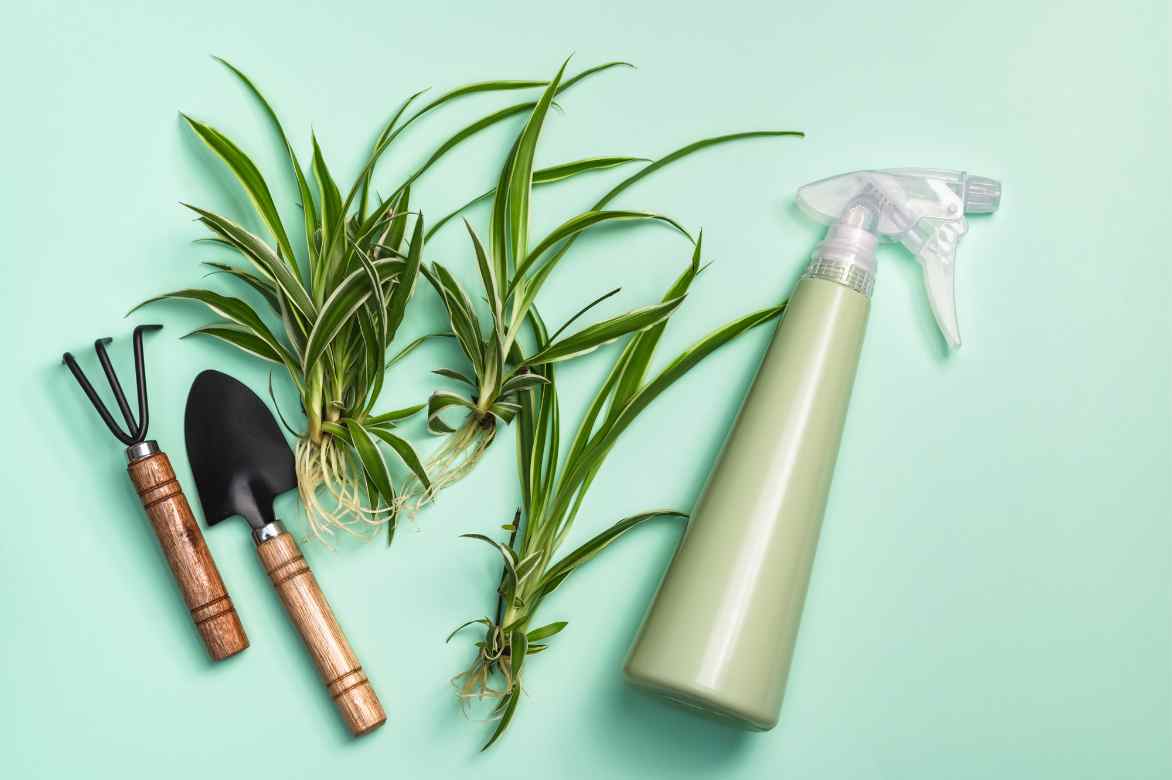
2. Layering in water
This method is quick and allows you to easily monitor root development.
Steps:
- Select a healthy seedling on a stolon.
- Place the seedling in a small glass or container filled with room-temperature water. Only the base of the leaves and the future roots should be submerged, not the leaves. (please note: you can also cut the seedling at the stolon to detach it from the mother plant)
- Change the water every 2 to 3 days to prevent it from stagnating.
- Within one to two weeks, new white, fine roots will appear.
- Once the roots are well-developed (around 3 to 5 cm), you can plant the young shoot in a pot with well-draining compost and water it lightly.
These two techniques are simple and offer a very high success rate. Layering in compost promotes quicker adaptation to the soil, while growing in water allows you to observe root growth and often appeals for its playful aspect. The choice is yours!
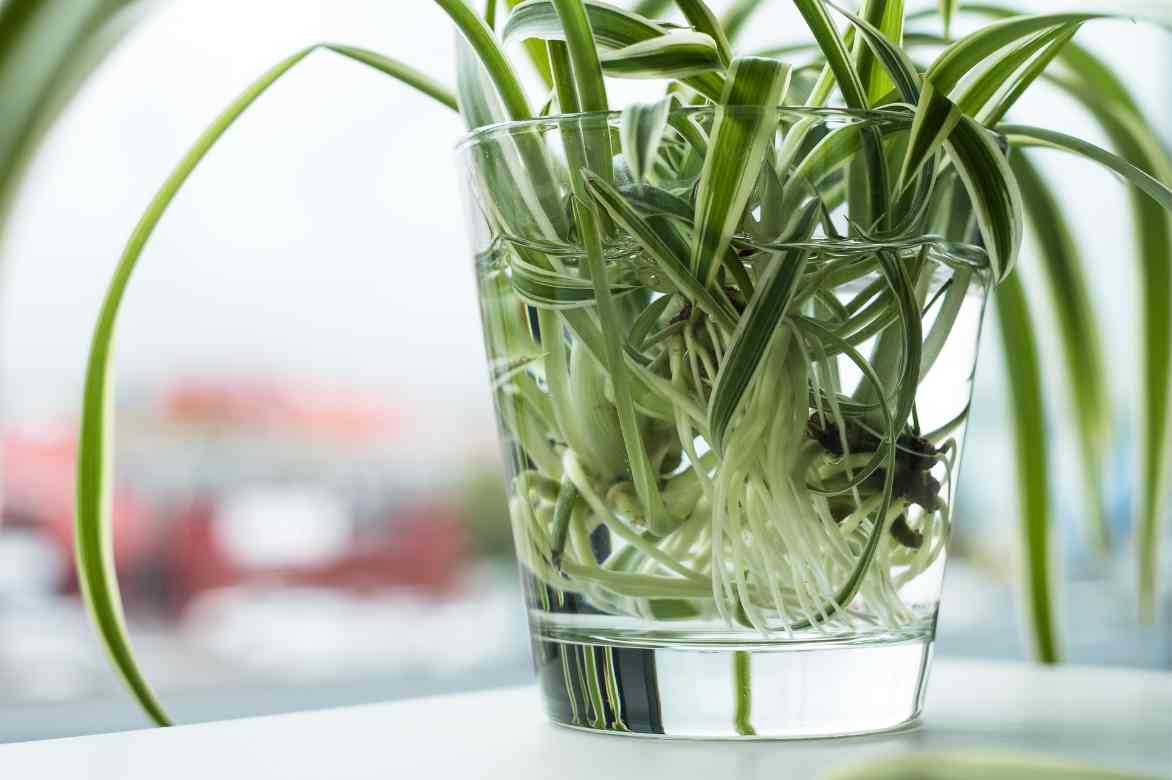
Water layering of Chlorophytum
How to best showcase your spider plant?
The Chlorophytum is a highly versatile plant that adapts perfectly to many interior styles thanks to its airy and elegant foliage. Its trailing habit and long ribbon-like leaves allow it to blend seamlessly into both modern decors and more bohemian or natural settings.
In Which Type of Interior?
- Modern or minimalist interiors: The Chlorophytum adds softness and lightness to clean lines. Its graphic foliage contrasts beautifully with raw materials like concrete or metal. It can be placed on a designer shelf or hung to break up the strict lines of the space.
- Bohemian or natural ambiance: With its cascading stolons, it fits perfectly into warm interiors dominated by wood, natural materials, and textured fabrics. It pairs wonderfully with natural fibre rugs, ethnic cushions, and artisanal objects.
- Vintage or retro style: Placed on a thrifted piece of furniture or in a colourful 70s-style pot, the Chlorophytum evokes retro atmospheres where green plants are omnipresent.
- Tropical or urban jungle decor: It perfectly complements a collection of exotic plants with its long leaves that create volume and movement. Paired with ferns, Monstera, or Pothos, it enhances the “indoor forest” effect.
- Office or workspace: Thanks to its air-purifying properties, it also finds its place on a desk, bringing freshness and vitality to a often more formal environment.
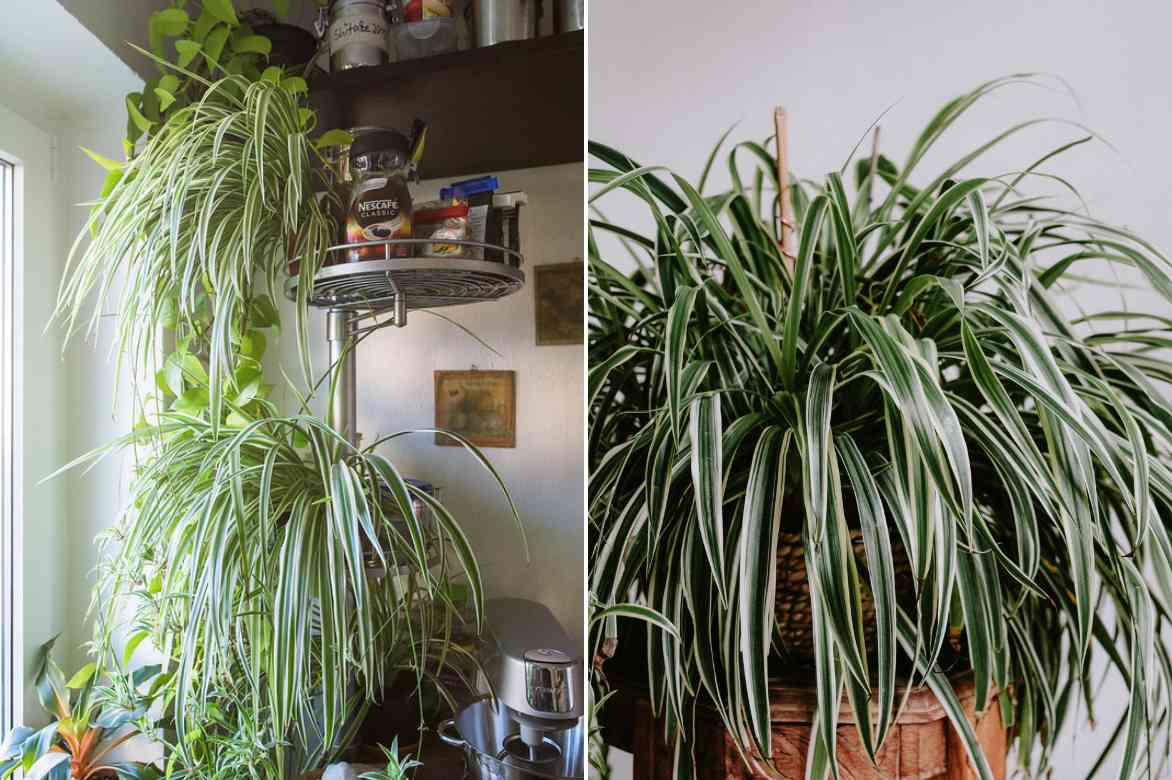
From the kitchen (© Maja Dumat) to the living room, the spider plant feels at home everywhere!
What Type of Pot to Showcase It?
- Macramé hanger or natural rope suspension: Ideal for playing with its trailing foliage and creating depth in a room. This type of support highlights its bohemian and light-hearted side.
- Terracotta pot, raw or glazed: The warmth of terracotta contrasts beautifully with its variegated leaves. Perfect for a Mediterranean or rustic decor.
- Coloured or pastel ceramic pot: In a modern or vintage interior, a colourful pot will highlight the vibrancy of its foliage. Soft colours like sage green, pale blue, or mustard yellow add pep without stealing the spotlight from the plant.
- Metal or brass hanging pot: For a more contemporary or industrial style, a hanging pot in gold or matte black metal creates an elegant contrast with its soft foliage.
- Wicker or natural fibre baskets: Perfect for a cosy and natural ambiance. This type of container gives the plant an authentic and warm touch.
Whatever the chosen decor, the Chlorophytum loves to be elevated. Placing it in a hanging position or on a high shelf allows you to fully enjoy its trailing stolons, creating a lovely vegetal movement in the room.
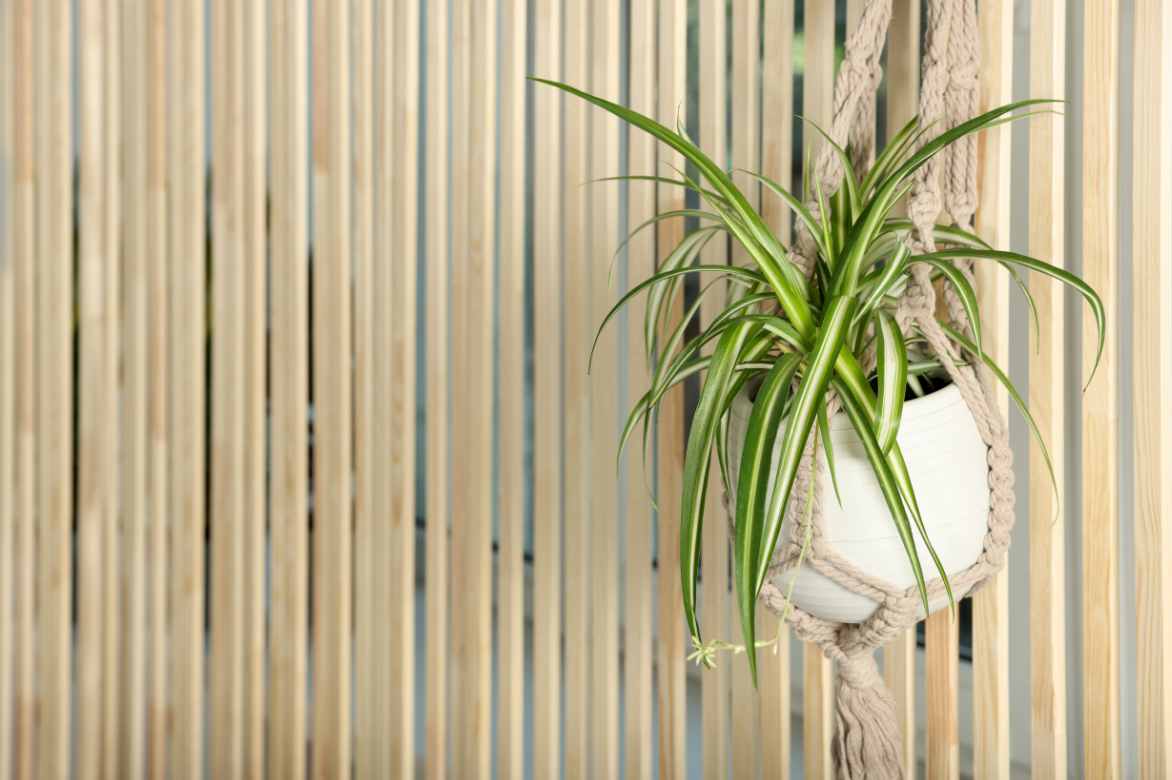
Chlorophytum and macramé: the perfect combo!
Also worth reading
→ Discover our wide range of houseplants
- Subscribe!
- Contents
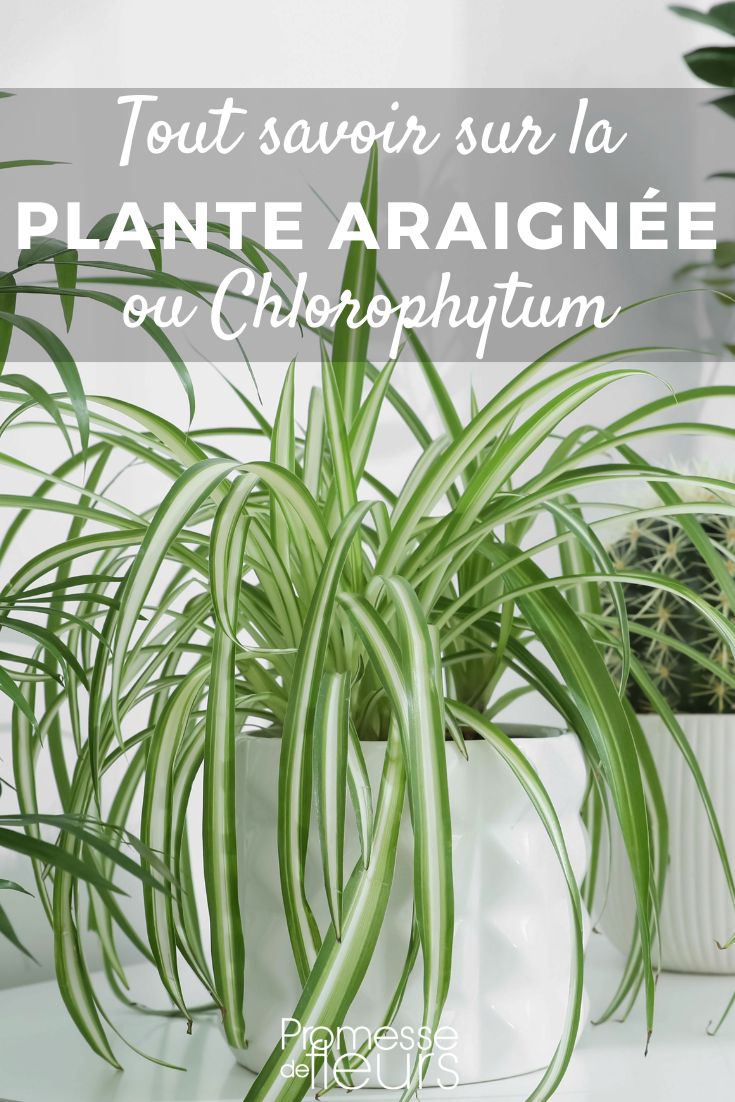































Comments